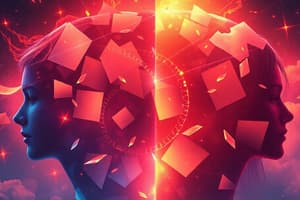Podcast
Questions and Answers
Which of the following best describes the concept of consciousness?
Which of the following best describes the concept of consciousness?
- An exclusive focus on external stimuli.
- Exclusive awareness of one's thoughts.
- Awareness of the self, bodily sensations, thoughts, and the environment. (correct)
- The suppression of bodily sensations.
Explicit attitudes are characterized by which of the following?
Explicit attitudes are characterized by which of the following?
- Attitudes that have less direct control over our actions.
- Feelings we are consciously unaware of.
- What we want to be true and what we think others want from us. (correct)
- Behaviors affected in ways we may not realize.
What is a key characteristic of implicit attitudes?
What is a key characteristic of implicit attitudes?
- They have a strong influence on conscious decision-making.
- They are feelings we aren't consciously aware of. (correct)
- They are easily and accurately reported by individuals.
- They are primarily shaped by societal expectations.
How does the Implicit Association Test (IAT) measure implicit attitudes?
How does the Implicit Association Test (IAT) measure implicit attitudes?
What is a limitation of the Implicit Association Test (IAT)?
What is a limitation of the Implicit Association Test (IAT)?
When are implicit and explicit attitudes MOST effective in predicting behavior?
When are implicit and explicit attitudes MOST effective in predicting behavior?
When are implicit attitudes a stronger predictor of behavior?
When are implicit attitudes a stronger predictor of behavior?
Which of the following statements best reflects the relationship between behaviors and attitudes?
Which of the following statements best reflects the relationship between behaviors and attitudes?
What is confabulation in the context of attitudes and behaviors?
What is confabulation in the context of attitudes and behaviors?
Which theory posits that we adopt attitudes that reduce tension caused by conflicting beliefs?
Which theory posits that we adopt attitudes that reduce tension caused by conflicting beliefs?
How does cognitive dissonance explain why someone might conclude that 'cheating isn't really wrong'?
How does cognitive dissonance explain why someone might conclude that 'cheating isn't really wrong'?
What does 'gradual escalation' refer to in the context of cognitive dissonance?
What does 'gradual escalation' refer to in the context of cognitive dissonance?
What is overjustification in the context of motivation and Cognitive-Dissonance Theory?
What is overjustification in the context of motivation and Cognitive-Dissonance Theory?
According to Cognitive-Dissonance Theory, actions driven by intrinsic motivation typically lead to?
According to Cognitive-Dissonance Theory, actions driven by intrinsic motivation typically lead to?
How does Self-Perception Theory explain the relationship between attitudes and behaviors?
How does Self-Perception Theory explain the relationship between attitudes and behaviors?
Which part of the brain is associated with assessing sensory input for potential threats, according to Self-Perception Theory?
Which part of the brain is associated with assessing sensory input for potential threats, according to Self-Perception Theory?
According to Self-Perception Theory, why does deep breathing make you feel calm?
According to Self-Perception Theory, why does deep breathing make you feel calm?
Which statement best summarizes how Cognitive-Dissonance Theory and Self-Perception Theory compare in explaining why actions affect attitudes?
Which statement best summarizes how Cognitive-Dissonance Theory and Self-Perception Theory compare in explaining why actions affect attitudes?
According to the material, what is reduced when other methods of affirming self-concepts are available?
According to the material, what is reduced when other methods of affirming self-concepts are available?
What is a key takeaway regarding the relationship between our conscious and unconscious minds?
What is a key takeaway regarding the relationship between our conscious and unconscious minds?
Flashcards
Consciousness
Consciousness
Awareness of self, bodily sensations, thoughts, and environment.
Explicit Attitudes
Explicit Attitudes
Attitudes we are consciously aware of, influencing our actions knowingly.
Implicit Attitudes
Implicit Attitudes
Attitudes we aren't consciously aware of, with less direct control, affecting behavior subconsciously.
Implicit Association Test (IAT)
Implicit Association Test (IAT)
Signup and view all the flashcards
Confabulation
Confabulation
Signup and view all the flashcards
Cognitive-Dissonance Theory
Cognitive-Dissonance Theory
Signup and view all the flashcards
Overjustification
Overjustification
Signup and view all the flashcards
Intrinsic Motivation
Intrinsic Motivation
Signup and view all the flashcards
Extrinsic Motivation
Extrinsic Motivation
Signup and view all the flashcards
Self-Perception Theory
Self-Perception Theory
Signup and view all the flashcards
Study Notes
- Consciousness refers to awareness.
- It includes awareness of:
- Self
- Bodily sensations
- Thoughts
- The environment
- Conscious and unconscious attitudes are explored.
Explicit Attitudes
- These attitudes reflect what we want to be true.
- Includes who we want to be.
- Includes what we think others expect from us.
Implicit Attitudes
- These attitudes are feelings we aren't consciously aware of.
- There is less direct control over these attitudes.
- They affect behavior in ways we may not realize.
- Response time can indicate implicit attitudes when making associations between concepts.
- Lying or misrepresenting requires more conscious thought.
- Reflected by physiological data
- Measurement is limited in predicting individual behavior.
- Measurement is useful in the aggregate
Predicting Behavior
- Using both implicit and explicit attitudes is most effective when used together.
- Implicit attitudes were stronger for early-life attitudes.
- Explicit attitudes were stronger for attitudes developed later.
- Behaviors often diverge from attitudes.
- Performing an action can change attitudes.
Confabulation
- We can generate false memories of emotion sources to fit current views or narratives.
- Applies to actions as well.
- We form and believe explanations for our actions.
Cognitive-Dissonance Theory
- Conflicts between beliefs cause tension.
- Attitudes are adopted to reduce tension.
- Example:
- Cheating is wrong, but a person who cheated sees themselves as good.
- This creates the tension, "If cheating is wrong, and I'm a good person, then how could I have cheated?"
- Resolution: Cheating isn't really wrong.
- This involves searching for justification and confirmation bias.
- A small wrong may be justified once committed.
- The justification can be applied to a larger wrong through gradual escalation.
- Desensitization occurs as a result.
Overjustification
- Providing too much incentive shifts the reason for actions from intrinsic to extrinsic.
- Intrinsic motivation drives actions by internal forces.
- Reading for enjoyment, studying psychology because the mind is interesting.
- Extrinsic motivation drives actions by external forces.
- Reading to impress others, studying psychology to get good grades and go to grad school.
- Intrinsically motivated actions create pleasure.
- Extrinsically motivated actions create exhaustion.
Self-Perception Theory
- Attitudes can be inferred by observing our actions.
Observable Outputs
- Our attitudes and perceptions may be handled by unconscious parts of brain.
- Hippocampus
- Amygdala assesses sensory input for threat.
- Activation of the amygdala triggers increased heart-rate, goosebumps, shaking, etc.
- Feelings are inferred by observing outputs.
- Deep breathing makes you feel calm
- Indicates parasympathetic activation: rest and digest.
- Slow breathing occurs when no threats are present.
- There's no need for anxiety if no threats are present.
- There's no need to breathe quickly if there's no anxiety.
- Process: Conscious action -> perception -> unconscious action.
Comparing Theories
- Both theories about actions affecting attitudes are supported to some extent.
- Dissonance: Justification of acts is reduced when other methods of affirming self-concepts are available.
- Self-perception: Attitudes follow behavior even when no contradiction or pressure to manage perceptions are present.
Conclusions
- Consciousness is not the sole director of our minds; the unconscious mind plays a significant role.
- The conscious mind creates stories and explanations for actions and attitudes.
Studying That Suits You
Use AI to generate personalized quizzes and flashcards to suit your learning preferences.




